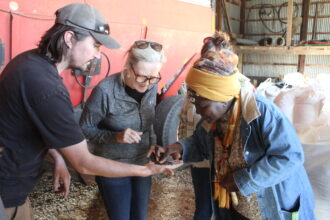For farmers interested in producing food-grade grains, there are unique opportunities, challenges, and considerations for growing and selling these higher-value crops. These grains, destined for direct human consumption or as ingredients in products, have a range of markets, from breweries and distilleries to co-op groceries and restaurants. However, navigating these specialized markets requires careful planning and access to focused resources. Enter the Artisan Grain Collaborative (AGC), a dedicated network of farmers, makers, and advocates committed to bolstering the Midwest grainshed from seed to table.
With the support of a $39,997 NCR-SARE Partnership grant, Alyssa Hartman, executive director of AGC, partnered with six farmers to develop resources for farmers interested in growing value-added food-grade grains.
“Improving access to high-value markets for small grains like wheat and rye can offer new avenues for more small and mid-size farmers to improve their ecological and economic resilience,” affirmed Hartman. “To support the successful growth and marketing of less common crops, farmers need comprehensive guidance, particularly on post-harvest handling.”
Highlighting the urgency of proper post-harvest management, Hartman recounted a cautionary tale from a central Illinois farmer involved in their project who suffered setbacks in the previous year when improper storage caused several tons of food-grade barley to spoil due to pest contamination. This underscores the need for resources and support systems.
A New Food-Grade Grain Resource
A major resource supported by the project was AGC’s “New Growers’ Guide to Producing Organic Food-Grade Grains in The Upper Midwest,” created in partnership with UW-Madison Extension and Michael Fields Agricultural Institute (MFAI). This comprehensive guide aims to fill critical knowledge gaps, equipping farmers with essential insights into the production, management, and storage of diverse grain varieties. Designed for new and experienced farmers, the guide has helpful information on growing culinary grains such as cereal rye, spring wheat, and corn—key food-grain grains in the region. It covers everything from seed sourcing to navigating crop management to post-harvest protocols. The new guide helps address crucial knowledge gaps, empowering farmers with essential insights into cultivating, managing, and storing diverse grain varieties.
Equipped with this resource, AGC members are expanding. In 2023, 58 AGC farmer members reported planting 19,867 acres of food-grade grains. Looking ahead, a promising 93% of AGC farmer members plan to expand their food-grade grain operations over the next 3-5 years, with 74% intending to increase acreage dedicated to these grains. Hartman is excited about the future and shared AGC’s plan to develop resources for other grains, such as barley and oats, alongside exploring pseudocereals and ancient grains.
Dig Deeper
AGC and the Michael Fields Agriculture Institute developed a video series featuring farmers growing food-grade wheat and rye on small and mid-size farms.
Apply for a Grant
NCR-SARE’s Partnership grant program starts accepting proposals in mid-August.
Want more information? See the related SARE grant:
This material is based upon work that is supported by the National Institute of Food and Agriculture, U.S. Department of Agriculture through the Sustainable Agriculture Research and Education (SARE) program. Any opinions, findings, conclusions, or recommendations expressed in this publication are those of the author(s) and should not be construed to represent any official USDA or U.S. Government determination or policy.
